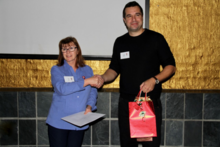Jérôme Lavoué, professeur au DSEST, était il y a peu un des invités à la Conférence annuelle du SAIOH (Southern African Institute for Occupational Hygien), à Gauteng en Afrique du sud. Son exposé, intitulé ''Exposure statistics : Pushing occupational exposure assessment into the Big data era'', a été présenté en séance plénière le vendredi 27 octobre 2017.
Voici le résumé, en anglais, de cette intervention :
Big data, data science, deep learning, these words have been buzzing around many aspects of our life recently. In essence, they mean leveraging data accumulated in the past to inform the future. A recent landmark example is the ever-improving quality of automated translation systems.
Leveraging past information to inform the future is not new in our field: many textbooks recommend performing literature reviews to inform a survey, However, these processes require assessors to painstakingly mentally mix this information with their own observation of the situation at hand.
Recent advances hint at likely progress in this area. Regarding sources of information, they include data stored in occupational exposure databanks, mostly from the 1980s onward, but also data from epidemiological studies, for which exposure was often assessed for thousands of individuals. Moreover, meta-analysis techniques are starting to be applied in industrial hygiene to perform automated literature reviews.
As for how to automatize the use of these resources, Bayesian statistics appear very promising. In addition to many other advantages over traditional approaches, they allow objective and transparent integration of several sources of information, including judgement and objective measurements, into a final statement about exposure and risk.
All these developments are exciting, but just as automated translation requires massive amounts of already translated text, it behoves us to continue generating and sharing documented exposure data to ensure future exposure predicting tools remain relevant and accurate.
